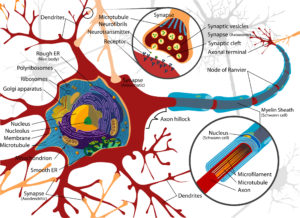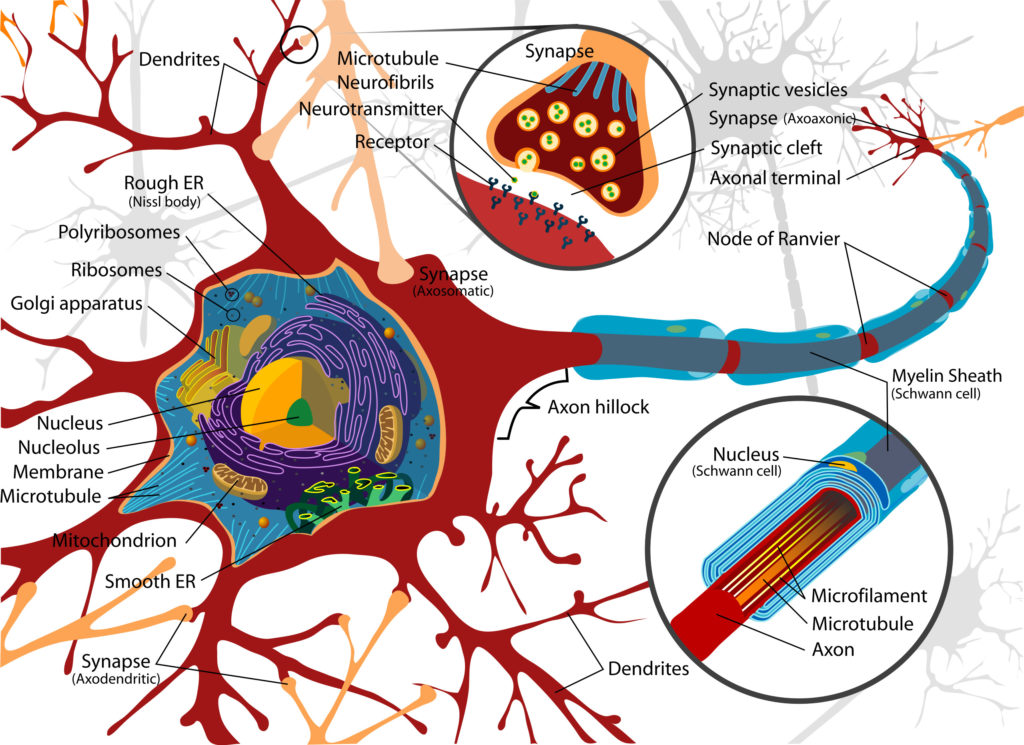
What is a nerve? They are bundles of nerve fibers called axons that connect neurons. They look like cables. Their job is to transmit electrical impulses.
All animals have nerves. They are the only way that living organisms can send signals from their brain to their muscles or parts of their bodies. The only animals that don’t have a nerve system are sponges and bloblike organisms called placozoans and mesozoans. Sponges don’t have a nervous system or a digestive system. They get food and oxygen by taking it directly from the water that flows through them. However, even without a nervous system, they can send signals using a cell called a cilium. Jellyfish do have a nervous system, but they don’t have a centralized brain. Their nervous system is divided into two parts: one net controls swimming, and the other net controls all of their other behavior. All multi-cellular organic life uses nerves to transmit electrical signals.
Nerves are made up of three parts: neurons, dendrites, and axons. Neurons are the cells that receive input from the body and send motor commands to our muscles. They are the drivers in the car. We have approximately 100 billion neurons in our brains. That is a lot, and it puts us second on the list of animals with the most neurons. We double the number of neurons that gorillas have, in third place, but we are dwarfed by the 257 billion neurons that African elephants have. The neuron is a cell that contains a nucleus and our DNA. Apart from the dendrites and axons, neurons are just like other cells. There are different types of neurons, such as motor neurons, sensory neurons, interneurons, and mixed nerves.
Dendrites stretch out from the neuron’s cell body. They look a lot like tree branches. Dendrites receive signals from other neurons and carry those signals into their own neuron cell. Those signals can either be excitatory, which means they make the neuron generate an electrical signal, or they are inhibitory, which means they prevent the neuron from generating an electrical signal. Dendrites receive this signal from the end of the axons of other neurons.
Axons are the nerve fibers and they extend out from the neurons. They can be shorter in a millimeter to longer than a meter, depending on their use. They end in an axon terminal and this terminal is very close to the dendrites of other nerves. They are very close, but they don’t touch. There is a gap of nanometers, called a synapse, and the signal is transmitted from the axons to the dendrites by neurotransmitters that reside in these synapses. Axons and dendrites are not attached to the neurons, they are a part of the neuron.
The difference in the neurons and the nerves becomes apparent here. Some nerves carry stimuli to the brain, some nerves carry commands away from the brain, and some nerves work on their own. Sensory nerves carry stimuli to the brain. These nerves have dendrites that are connected to the cells that detect sensation, such as in our ears, or in our skin. They receive the sensory input and send it as an electrical signal to the neuron. The neuron reacts to this signal by either sending an electrical signal along its axon to another neuron or not firing. If a physical reaction is required, this signal reaches the motor part of the brain. The motor neurons receive the signal along their dendrites, making them send an electrical signal along their axons, which connect to the muscles, causing motion. There are also interneurons, which connect neurons to other neurons in the spine. They are capable of acting on their own, without involving the brain. This is how our reflexes work.
Why did we evolve nerves? It seems unusual that all animals could have evolved with the same kind of nervous system. However, rather than being unusual it shows that nearly all complex life on this planet has evolved from the same ancestor. The ancestor of all complex life evolved a system of nerves, and they were so good at keeping the animal alive that they got passed on. That being said, nerves must have evolved twice on Earth because animals like squid have a different type of nervous system. Still, it is wonderful to think that we have this complex nervous system because an animal evolved it hundreds of millions (possibly even a billion) years ago. And this is what I learned today.
Image By LadyofHats – Own work. Image renamed from Image:Complete neuron cell diagram.svg, Public Domain, https://commons.wikimedia.org/w/index.php?curid=3970826
Sources
http://www.scholarpedia.org/article/Nervous_system
https://my.clevelandclinic.org/health/body/22584-nerves
https://en.wikipedia.org/wiki/Nerve
https://en.wikipedia.org/wiki/Axon
https://en.wikipedia.org/wiki/Neuron
https://en.wikipedia.org/wiki/Dendrite
https://byjus.com/biology/nerves/
https://www.biomedcentral.com/about/press-centre/science-press-releases/13-jan-2014
https://www.nbcnews.com/id/wbna28865038
https://qbi.uq.edu.au/brain/brain-anatomy/axons-cable-transmission-neurons
https://qbi.uq.edu.au/brain/brain-anatomy/what-neuron
https://faculty.washington.edu/chudler/cells.html
https://www.verywellhealth.com/what-is-an-axon-5190652
https://www.verywellhealth.com/neurons-5217652
https://news.mit.edu/2018/dendrites-explain-brains-computing-power-1018


Pingback: How are memories stored? | I Learned This Today